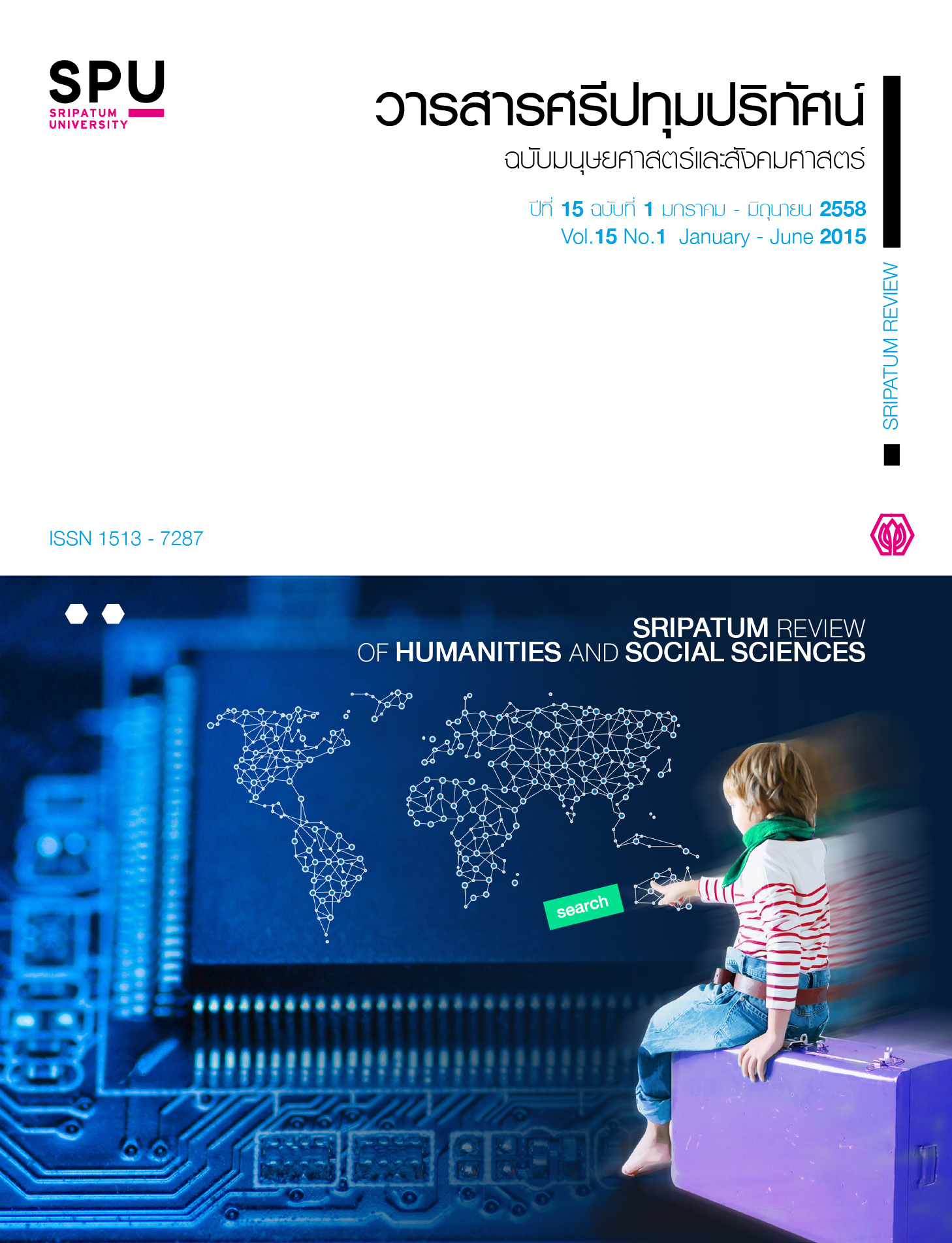THE GUIDELINES FOR DEVELOPMENT OF POLICY ON THAILAND’S TEXTILE INDUSTRY TO ACCOMMODATE THE JOINING OF ASEAN ECONOMIC COMMUNITY
Main Article Content
Abstract
The objectives of this research were: (1) to study the impacts of Thailand’s joining ASEAN Economic Community (AEC) on Thai textile industry, (2) to find out the guidelines for potential development of Thailand’s textile entrepreneurs, and (3) to find out the guidelines for development of policy on Thailand’s textile industry to accommodate the joining of AEC. This study employed the qualitative research methodology with the use of documentary review and in-depth interviews of 13 experts. The research instrument was a structured interview form. Research findings were as follows:
1. The positive impacts of joining the AEC on Thailand’s textile industry are the expansion of market and the increase of demand for Thai textile products; while the negative impacts are that the competition in this industry will be intensified and cheap textile products will flow into Thailand resulting in negative effects on SMEs in Thailand. Details for each issue are as follows: (1) the export values of upstream and midstream industry products will increase, while that of the downstream industry products will increase slightly; (2) the quality of Thai textile products will be accepted by international market; (3) the free flow of labor forces will occur in only 7 branches; (4) the trend is increasingly competitive, Thailand’s textile industry should create products that the market demands, and Thailand should increase her investment in the AEC countries; and (5) the joining of AEC will not affect relocation of production bases.
2. The guidelines for potential development of Thai textile entrepreneurs are as follows: (1) the readiness preparation on language skills; the learning of each country’s context; the integration into groups; the modern organizational management; and the possession of vision, mission, and business plans; (2) the enhancement of capability on human resource development, research and development, and innovations; (3) the state sector should provide supports on budget, knowledge, rules, regulations, practices, and privilege for textile entrepreneurs, and it should help in finding new markets.
3. The guidelines for development of policy on Thailand’s textile industry are as follows: (1) the promotion of hi-tech and clean products and application of technology in the production, and the promotion of creative thinking and innovations; (2) the promotion of human resource development and knowledge management; (3) the promotion of research and development on production technology; (4) the development of raw materials; (5) the opening of new markets; (6) the promotion for formulation of industrial clusters; (7) the provision of supports to logistics system; and (8) the modification of inappropriate tax system.
Article Details
1. กองบรรณาธิการสงวนสิทธิ์ในการพิจารณาและตัดสินการตีพิมพ์บทความในวารสาร
2. บทความทุกเรื่องจะได้รับการตรวจสอบทางวิชาการโดยผู้ทรงคุณวุฒิ แต่ข้อความและเนื้อหาในบทความที่ตีพิมพ์เป็นความรับผิดชอบของผู้เขียนแต่เพียงผู้เดียว มิใช่ความคิดเห็นและความรับผิดชอบของมหาวิทยาลัยศรีปทุม
3. การคัดลอกอ้างอิงต้องดำเนินการตามการปฏิบัติในหมู่นักวิชาการโดยทั่วไป และสอดคล้องกับกฎหมายที่เกี่ยวข้อง
References
จุฑา เทียนไทย. 2555. ผลกระทบของประชาคมอาเซียนต่อธุรกิจไทย และกลยุทธ์ในการตั้งรับ. สืบค้นเมื่อ 6 กรกฎาคม 2557.
เจน นำชัยศิริ. 8 มีนาคม 2557. รองประธานสภาอุตสาหกรรมแห่งประเทศไทย.สัมภาษณ์.
ชนินทร์ ชุณหพันธรักษ์. ม.ป.ป. AEC: ประชาคมเศรษฐกิจอาเซียนผลกระทบและการปรับตัวของอุตสาหกรรมไทย.
เดช พัฒนเศรษฐพงษ์. 10 พฤษภาคม 2557. อดีตนายกสมาคมเครื่องนุ่งห่มไทย.สัมภาษณ์.
ธัศภรณ์ฌณก จันทระ. 2555. อนาคตอุตสาหกรรม สิ่งทอไทย. กรุงเทพฯ : สำนักงานเศรษฐกิจ อุตสาหกรรม.
ธานินทร์ ผะเอม. 29 พฤษภาคม 2557.รองเลขาธิการคณะกรรมการพัฒนาการเศรษฐกิจและสังคมแห่งชาติ. สัมภาษณ์.
นิสวันต์ พิชญ์ดำรง. 2556. สัมภาษณ์พิเศษ “ไทยกับการเข้าสู่ประชาคมอาเซียน”. วารสาร เศรษฐกิจและสังคม. 50, 2: 2-8.
เบญจพล มีเงิน. 2551.คลัสเตอร์ อุตสาหกรรม: การได้มาซึ่งความได้เปรียบเชิงการ แข่งขันขององค์กรธุรกิจจากการรวมกลุ่มคลัสเตอร์ อุตสาหกรรมสิ่งทอในระเทศไทย.ปรัชญาดุษฎีบัณฑิต. มหาวิทยาลัยรามคำแหง.
ฝ่ายวิจัยและการจัดการนโยบาย 5.2556. บทวิเคราะห์การจัดอันดับความสามารถในการแข่งขันของประเทศไทยประจำปี 2012-2013 โดย World Economic Forum: WEF. สืบค้นเมื่อ 2 กรกฎาคม 2557.
รู้ทัน AEC.2013. ธุรกิจสิ่งทอของไทยกับการเปิดAEC. วารสาร TPA News. 17(197): 37-38.
วงศกร ตระกูลหิรัญผดุง. 2553. อุตสาหกรรม สิ่งทอและเครื่องนุ่งห่มไทย.ยังโตได้อีก.For Quality. 16, 147: 18-22.
วนิดา พิชาลัย. 22 เมษายน 2557. ผู้อำนวยการฝ่ายนโยบายและแผนพัฒนาอุตสาหกรรม สถาบันพัฒนาอุตสาหกรรมสิ่งทอ. สัมภาษณ์.
วนิดา ศักดิ์สงวนมนูญ. 2555. อนาคตสิ่งทอไทย.ร่วงหรือโรจน์. สืบค้นเมื่อ10 มิถุนายน 2557.
วีระศักดิ์ อุดมกิจเดชา. 23 เมษายน 2557.ผู้อำนวยการศูนย์เทคโนโลยีโลหะและวัสดุแห่งชาติ. สัมภาษณ์.
ศศิธร พลัตถเดชและศวรรณรัตน์ จิตรเกษมสำราญ. 2556. แผนรับมือการเข้าสู่ประชาคมเศรษฐกิจอาเซียน.วารสารเศรษฐกิจและสังคม. 50, 2: 9-13.
สถาบันพัฒนาอุตสาหกรรมสิ่งทอ. ม.ป.ป. รายงานการศึกษาฉบับสมบูรณ์ยุทธศาสตร์และแผนแม่บทเพื่อเพิ่มขีดความสามารถในการแข่งขันสำหรับอุตสาหกรรมสิ่งทอและเครื่องนุ่งห่ม (2550-2554). สมุทรปราการ : อาร์ตแอนด์พาร์ท อัพเดต จำกัด.
สถาบันพัฒนาอุตสาหกรรมสิ่งทอ. 2554. แผนแม่บทการพัฒนาอุตสาหกรรมสิ่งทอและเครื่องนุ่งห่มไทย (พ.ศ. 2555-2559).กรุงเทพฯ: สำนักงานปลัดกระทรวงอุตสาหกรรม.
สัมฤทธิ์ ยศสมศักดิ์. 2549. การบริหารทรัพยากรมนุษย์ หลักการและแนวคิด.กรุงเทพฯ: เอ็ม.ที. เพรส.
สาธิต พุทธชัยยงค์. 21 มีนาคม 2557. อธิการบดี มหาวิทยาลัยเทคโนโลยีราชมงคลกรุงเทพ.สัมภาษณ์.
สำนักงานเศรษฐกิจอุตสาหกรรม. 2554. สถิติสิ่งทอไทย 2553-2554. กรุงเทพฯ: สถาบันพัฒนาอุตสาหกรรมสิ่งทอ.
สุกิจ คงปิยาจารย์. 30 เมษายน 2557. นายกสมาคมอุตสาหกรรมเครื่องนุ่งห่มไทย.สัมภาษณ์.
สุจิระ ขอจิตต์เมตต์. 20 มีนาคม 2557. ผู้ช่วยอธิการบดีมหาวิทยาลัยเทคโนโลยีราชมงคลธัญบุรี. สัมภาษณ์.
สุรินทร์ พิศสุวรรณ. 22 เมษายน 2557. อดีตเลขาธิการอาเซียน. สัมภาษณ์.
Ceran, M. B., Erturk & Ozkurkcler, H. A. 2014. The Important of Logistics Village in increasing international trade: The case of Turkey-Italy. Economics, Management, and Financial Market. 9, 1: 351-361.
Mondy, R. W., Noe, R.M. & Premeaux, S.R. 2002. Human Resource Management 8th ed. New Jersey: Pearson Education.
Office of Small and Medium Enterprise Promotion. 2011. Prevailing Issues on AEC for SMEs In Thailand. Retrieved June 10, 2014.
Trairatvorakul, P. 2011. ASEAN Economic Community 2015: Opportunities or Threats?. Sasin Update-Reunion 2011, Sasin Hall.Thursday, 15 September 2011.
Transportation & Logistics/SMEs & Franchise. 2556. ส. พัฒนาสิ่งทอหนุนใช้ “เส้นใยชีวภาพเพิ่มศักยภาพอุตสาหกรรมสิ่งทอไทย”. Global Business. 6,168: 1-2.
Watchravesringkan, K., Karpova, E., Hodges, N. N., & Copeland, R. 2010. The competitive position of Thailand’s apparel industry: Challenges and
opportunities for globalization. Journal of Fashion Marketing and Management. 14, 4: 576-597.


